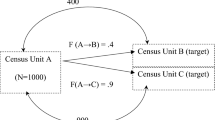Abstract
Several studies employed different algorithms in order to investigate criminal’s spatial behaviour and to identify mental models and cognitive strategies related to it. So far, a number of geographic profiling (GP) software have been implemented to analyse mobility and its relation to the way criminals are using spatial environment when committing a crime. Since crimes are usually perpetrated in the offender’s high-awareness areas, those cognitive maps can be employed to create a map of the criminal’s operating area to help investigators to circumscribe search areas. The aim of the present study was to verify accuracy of simple statistical analysis in predicting spatial mobility of a group of 30 non-criminal subjects. Results showed that statistics such as Mean Centre and Standard Distance were accurate in elaborating a GP for each subject according to the mobility area provided. Future analysis will be implemented using mobility information of criminal subjects and location-based software to verify whether there is a cognitive spatial strategy employed by them when planning and committing a crime.
Similar content being viewed by others
References
Bottoms AE (2007) Place, space, crime, and disorder. In: Maguire M, Morgan R, Reiner R (eds) The oxford handbook of criminology, 4th edn. Oxford University Press, Oxford
Brantingham PJ, Brantingham PL (1981) Environmental criminology. Waveland Press, Prospect Heights
Chainey S, Ratcliffe J (2005) GIS and crime mapping. Wiley, England
Encarta® World English Dictionary [North American Edition]© & (P) (2009) Microsoft Corporation
Levine N (2010) CrimeStat: A Spatial Statistics Program for the Analysis of Crime Incident Locations (v 3.3). Ned Levine and Associates, Houston, TX, and the National Institute of Justice, Washington, DC
Luini LP, Mastroberardino S, Marucci FS (2009) Investigating spatial behaviour: an application of space analysis to criminal investigations. Cogn Process 10:S247–S249
Parziale G (2011) Nuove tecniche di analisi investigativa. Il mostro di Cassibile: dal profilo geografico all’analisi territoriale come supporto all’investigatore sul campo. Unpublished thesis work
Rossmo DK (2000) Geographic profiling. CRC Press, Boca Raton
Santtila P, Laukkanen M, Zappala` A (2007) Crime behaviours and distance travelled in homicides and rapes. J Investi Psychol Offender Profiling 4:1–15
Shaw CR, McKay HD (1931). Social factors in Juvenile delinquency. Report on the causes of crime, National commission of law observance and enforcement, vol. 2. Washington, DC: Government printing office
Shaw CR, Zorbaugh FM, McKay HD, Cottrell LS (1929) Delinquency areas. University of Chicago Press, Chicago
Conflict of interest
This supplement was not sponsored by outside commercial interests. It was funded entirely by ECONA, Via dei Marsi, 78, 00185 Roma, Italy.
Author information
Authors and Affiliations
Corresponding author
Rights and permissions
About this article
Cite this article
Luini, L.P., Scorzelli, M., Mastroberardino, S. et al. Spatial cognition and crime: the study of mental models of spatial relations in crime analysis. Cogn Process 13 (Suppl 1), 253–255 (2012). https://doi.org/10.1007/s10339-012-0486-4
Published:
Issue Date:
DOI: https://doi.org/10.1007/s10339-012-0486-4




